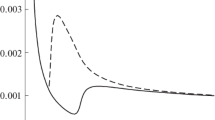Abstract
A comparative analysis is performed for a complete locally anisotropic turbulence model of the second order and existing turbulence models. The comparison draws on experimental data, data of a direct numerical simulation of the nonstationary Navier-Stokes equations for a developed channel flow and a uniform channel flow with a constant velocity shift, and results for turbulence damping behind a grid. The K-ɛ model and the quasi-isotropic turbulence model are shown to have marked disadvantages, especially in describing turbulent flows with a high degree of anisotropy of pulsatory motion. Use of a locally anisotropic turbulence model improves the accuracy of determining Reynolds stresses. Consideration is given to the advantages and disadvantages of the turbulence models discussed.
Similar content being viewed by others
References
V. C. Patel, W. Rodi, and G. Scheuerer,AIAA J.,23, 1308–1319 (1985).
W. Rodi and N. N. Mansour,J. Fluid Mech.,250, 509–529 (1993).
E. P. Sukhovich,Izv. Akad. Nauk Latv. SSR, Teplofiz. Gidrogazodinamika, No. 1, 65–72 (1990).
B. E. Launder, G. J. Reece, and W. Rodi,J. Fluid Mech.,68, 537–566 (1975).
T. B. Gatski and C. G. Speziale,J. Fluid Mech.,254, 59–78 (1993).
B. E. Launder, in: A. S. Ginevskii (ed.),Turbulent Shear Flows [Russian translation], Vol. 1, Moscow (1982), pp. 270–279.
B. E. Launder and A. Morse, in: A. S. Ginevskii (ed.),Turbulent Shear Flows [Russian translation], Vol. 1, Moscow (1982), pp. 291–310.
E. P. Sukhovich,Inzh.-Fiz. Zh.,72, No. 3, 576–583 (1999).
E. P. Sukhovich,Inzh.-Fiz. Zh.,72, No. 4, 663–671 (1999).
E. P. Sukhovich,Inzh.-Fiz. Zh.,72, No. 5, 886–895 (1999).
S. Tavoularis and S. Corrsin,J. Fluid Mech.,104, 311–367 (1981).
F. H. Champagne, V. G. Harris, and S. Corrsin,J. Fluid Mech.,41, Pt. 1, 81–139 (1970).
V. G. Harris, J. A. Graham, and S. Corrsin,J. Fluid Mech.,81, Pt. 4, 657–687 (1977).
S. Tavoularis and U. Carnik,J. Fluid Mech.,204, 457–478 (1989).
E. P. Sukhovich,Izv. Akad. Nauk Latv. SSR, Teplofiz. Gidrogazodinamika, No. 3, 68–84 (1988).
W. J. Feiereisen, E. Scirani, J. H. Ferziger, and W. C. Reynolds, in:Turbulent Shear Flow, Vol. 3 (1982), pp. 309–321.
M. Gad-el-Hak and S. Corrsin,J. Fluid Mech.,62, Pt. 1, 115–143 (1974).
N. N. Mansour, J. Kim, and P. Moin,J. Fluid Mech.,194, 15–44 (1988).
M. M. Rogers and P. Moin,J. Fluid Mech.,176, 33–66 (1987).
M. J. Lee, J. Kim, and P. Moin,J. Fluid Mech.,216, 561–583 (1990).
Author information
Authors and Affiliations
Additional information
Translated from Inzhenerno-Fizicheskii Zhurnal, Vol. 73, No. 2, pp. 328–339, March—April, 2000.
Rights and permissions
About this article
Cite this article
Sukhovich, E.P. Comparative analysis of turbulence models. J Eng Phys Thermophys 73, 318–329 (2000). https://doi.org/10.1007/BF02681737
Received:
Issue Date:
DOI: https://doi.org/10.1007/BF02681737



